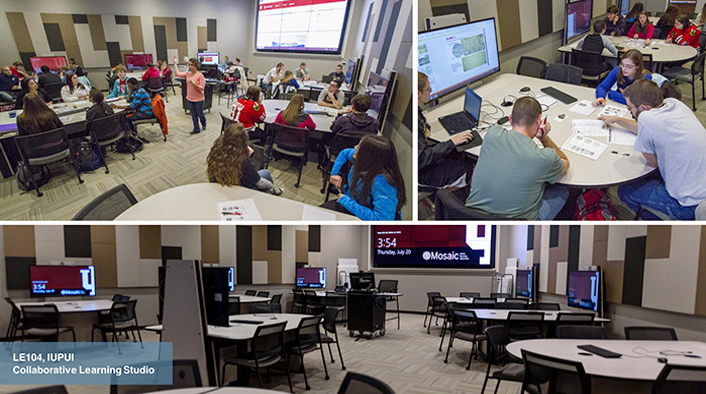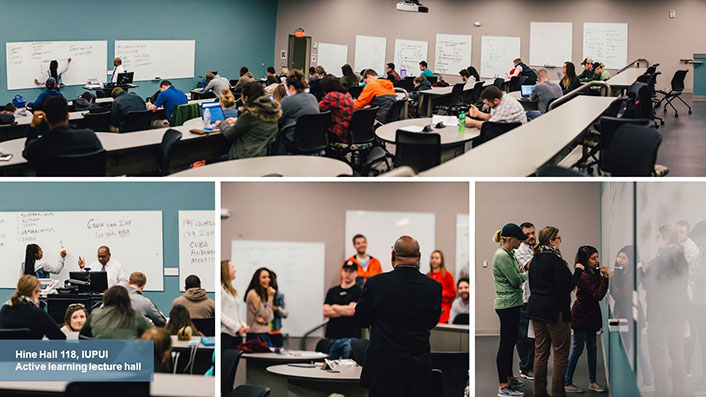Are we creating the right blend of active learning classrooms? How will we know what types of classrooms we need? These questions led to a comprehensive classroom needs analysis that would provide the foundation for the creation of a classroom master plan.

You may have heard of a campus master plan before, but what about a classroom master plan? Why is a classroom master needed? Many universities have campus master plans to provide a roadmap for the evolution of the physical campus, but few universities create classroom master plans that take into account the different learning environments needed to support the instructional goals of schools and departments. For example, a classroom master plan might address how many different active learning classrooms (ALCs) an institution needs for a given discipline compared to more traditional learning spaces. Data from faculty, students, and campus administrative units that support instruction should inform the plan. Indiana University (IU) had undertaken the development of a process for creating classroom master plans for each of the institution's campuses.
As part of the Mosaic Active Learning Initiative, IU has been intentional in creating new ALCs to better support the active learning pedagogies that improve teaching and learning. IU's approach to ALCs is unique in that, as in any mosaic, there is not a standard design for ALCs across our campuses. Depending on the number of students a classroom would accommodate (e.g., 20, 50, 150) and the disciplines that may use the room, we view each classroom differently (see figure 1). The challenge for our university, then, is to determine how best to support customized classroom redesigns that focus on active learning while respecting equity and differentiation.

For the two largest campuses—Indiana University (IU Bloomington) and Indiana University–Purdue University Indianapolis (IUPUI)—we have approached this challenge by establishing classroom committees that review classroom redesign proposals each year. These committees prioritize which classrooms are in the greatest need for redesign and then allocate funding based on this prioritization process. As a result, whenever we have an opportunity to redesign an existing classroom and/or build a new classroom, we seize the opportunity.
Getting Started
Is simply seizing opportunities when they arise enough? Are we creating the right blend of ALCs that will support active learning in a wide range of disciplines? How will we know what types of classrooms we need? As we considered these questions, it became clear that we should be intentional about faculty and student needs as they relate to classroom usage and support for student learning. The goal, through a year-long comprehensive needs analysis, would be to then develop a classroom master plan for IUPUI.
To conduct a classroom needs analysis, we quickly learned that many stakeholders needed to be involved, research questions had to be formulated, and a data collection plan needed to be designed. In fall 2017, a research team began meeting monthly, and we held a subcommittee retreat midyear to move the project forward at full steam. The following research questions emerged:
- Which of the reported instructional strategies did faculty find valuable?
- What classroom features do faculty perceive as desirable for teaching and learning purposes? Why?
- What classroom features do students perceive as desirable for face-to-face learning purposes?
Data Collection
Given the complexity of the job to be done, the research team settled on a mixed-methods approach that included faculty and student surveys, focus groups, and individual semi-structured interviews.
- Faculty survey: This survey, which was administered online to all IUPUI faculty in fall 2017, asked respondents to identify the instructional strategies they used in a typical week in the previous semester, as well as to identify desirable classroom features. A total of 2,380 faculty received the survey, and there were 1,170 respondents (response rate 49%).
- Faculty focus groups: Forty-three faculty were recruited to participate in focus groups on the basis of whether they taught in general inventory classrooms and would be interested in speaking about their teaching approaches and how classroom spaces might be designed to facilitate their teaching and student learning. Faculty of any rank or status (e.g., full- or part-time) were included.
- Faculty semi-structured interviews: We conducted 30-minute interviews with faculty who had been randomly assigned through the registrar to teach the same course in the same semester (fall 2017) in both an active learning classroom and a traditional classroom. Six instructors from various departments (psychology, business, liberal arts, engineering, and technology) participated in these interviews.
- Student survey: This survey was administered online to students who took a class in spring 2018 in one of a designated set of active learning classrooms at IUPUI. The survey asked students to speak to the instructional strategies their instructors used in the classroom. Students also identified features that they valued in those classrooms. The questions posed were informed by Version 2 of the Learning Space Rating System developed by EDUCAUSE. A total of 6,551 university students received the survey, and 503 responded (response rate of 7.7%).
Findings
The instruments used within the study and full results appear in IUPUI Classroom Needs Analysis 2018, an online, open-source book. Key findings and recommendations that came from the needs analysis are as follows:
- The analysis revealed that the pedagogical strategies most frequently adopted by faculty were interactive lectures, class discussion, collaborative learning, and group activities. Lectures without participation were the least common—an encouraging sign that we should continue to build spaces that foster active learning pedagogies. Additionally, to support these active learning pedagogies, logistical issues that are easily remedied should be addressed. For example, all classrooms should have sufficient whiteboards and markers for use by both instructors and students.
- The classroom attributes rated most highly by students include adequate desk space and the ability to move freely through the space. Although active learning spaces often have moveable chairs with individual desk space attached, students in our study longed for more room. As we continue to renovate our spaces, we must also be aware that today's students will bring multiple mobile devices to class. Adequate desk space to accommodate multiple devices is critical, which makes moveable tables preferable to chair/desk combinations. Additionally, when space is too tightly packed with students or furniture, movement can be severely compromised, a problem highly evident in lecture hall rooms created with stadium seating and fixed seating.
- With the increase of devices in class, sufficient electrical power and Wi-Fi access are needed. Student surveys quickly identified the rooms with weak Wi-Fi connections and where power outlets were limited. These issues are more easily remedied than a complete remodel of a space where new furniture would need to be purchased.
- Informal student spaces should be intentionally designed to complement active learning classrooms, so they become extensions of the learning environment. As instructors encourage students to engage in active learning pedagogies, having space for the students to interact during break out activities and small group work sessions is key. The creation of small working rooms in and around classroom spaces will allow for collaborative activities, both inside and outside of class.
A key takeaway for all those who are interested in conducting a classroom master plan is to prioritize classroom renovations identified by students as being the most pressing.
Active learning in IUPUI's LE104
Recommendations
- Start small, but dream big! Starting at the department or college level may be necessary, but contact your EVPs/VPs to see if the local initiatives would scale well for the entire institution.
- Bring multiple stakeholders to the table. Include faculty, students, researchers, graduate students, teaching center staff, learning space designers, and architects.
- Develop a plan for research that includes research-question development, identification of data to be gathered, and a timeline for completion.
- Do not reinvent the wheel. Use resources like Flexspace.org, the LSRS rating system developed by EDUCAUSE, the Active Learning Classroom Observation Tool, and the instruments used in this study to serve as a guide as you determine what data collection instruments you want you use and the data you wish to gather.
- Build the right team from the outset. Delegate research tasks to teams of two or three who can oversee an aspect of the study from beginning to end.
- Publish your findings. Consider an e-book or open-source format where you can receive additional feedback from your results.
- Create an action plan based on the results. Once you learn about issues, be prepared to address them in the best manner available to you.
- Be prepared to continually revisit your classroom master plan/needs analysis in future years. Needs evolve and change and new issues emerge. Be prepared to continually evolve.
Next Steps
The IUPUI classroom committee now has a charge to formulate a plan for acting on these recommendations and to develop a preliminary classroom master plan during the fall of 2019. With the data gathered, we can target specific rooms in particular buildings where problems can be easily remedied, as well as classrooms that will need significant renovations. We view this needs analysis as a first step that helps us strategically determine the priorities of our faculty and students. Additionally, we intend to repeat our needs analysis in the upcoming years to identify new classroom issues that emerge, as well as to maintain a pulse on teaching and learning needs of the students and faculty.
Anastasia Morrone is Associate Vice President for Learning Technologies and Professor of Educational Psychology at Indiana University.
Tiffany Roman is Assistant Professor of Instructional Technology at Kennesaw State University.
© 2019 Anastasia Morrone and Tiffany Roman. The text of this work is licensed under a Creative Commons BY 4.0 International License.
